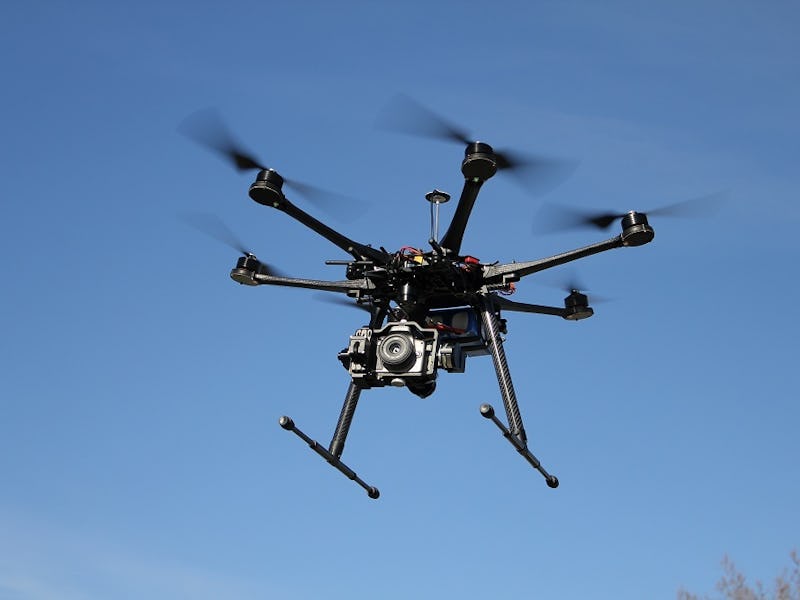Drones Are Remote Control Cinematographers
Why unmanned aerial vehicles are changing the way we film in the sky.

September 9 through 11 marked the 2015 InterDrone Conference, the nation’s premier annual gathering on the state of commercial drones. Technical experts, industry moguls, and plain old enthusiasts from around the country come together to talk the wondrous world of unmanned aerial vehicles. We’re highlighting some of the more interesting topics and issues that were discussed.
One of the most notable things about Interdrone 2015 was how much love attendees had for drone videography and filmmaking. The conference this year includes a drone film festival where various judges will go through a series of short films and award cash prizes to select winners.
One of those judges was Ty Audronis, a renowned drone videographer who operates his own aerial videography company and a YouTube channel full of incredibly cool aerial clips. Inverse spoke with Audronis to learn more about the world of drone videography and what’s in store for the future of aerial moviemakers.
What kind of equipment do you use?
I use one of several drones when I go out to shoot. I use a small drone like a DJI Phantom if I’m doing indoor shots, like inside casinos, or a DJI S900, which is a fairly large hexacopter if I’m doing shooting for TV or film outdoors. You can set that one up one of two ways: You can have two operators — one flying and one controlling the camera; or you can use it as a single-operator like you would a Phantom.
The batteries on these things are crazy. On the S900, they’re 22 pounds, and have enough power to start three semi trucks.
What are the advantages to using drones, as opposed to other tools and techniques for aerial videography?
Let me clear up a misconception first: drones can’t replace helicopters or steady cams or crane arms. A multicopter can’t do any of those jobs better than those pieces of equipment can. It’s close, but not as good.
What a drone can do is combine the jobs those things do in interesting ways. Instead of just a list of a camera, you can have a list of a camera through a window flying the hallway of a house. Things like that.
Also, below 500 feet, traditional helicopters are very dangerous. They’ll be picking up what a lot of aircraft people call FOD — foreign object debris. So it becomes safer to use a multicopter below 500 feet. A drone can get into much tighter spaces.
What kinds of skills does someone need to pick up to become a good drone videographer? Is this very difficult or time-consuming? Or is this fairly easy that a hobbyist could pick up pretty easily?
It’s not difficult to pick up, provided someone has a healthy respect for the technology and skill required. The problem — which is actually both a blessing and a curse — is how easy it is to fly a multicopter. It’s also a blessing and a curse how easy it is to operate some camcorders, with just a push of a button.
Unfortunately, there’s no skill switch on either. Both are unique to master. Good RC pilot skills can take a while to cultivate. Similarly, people go to school for years to learn cinematography on the ground. It’s not easy to be a cinematographer in the air.
The best thing for people to do is to go through a learning process. Don’t just go out there and throw up a drone into the air. Get a simulator. At least take one videographer course at a local community college. Learn the basic principles so you have a foundation.
Can you describe two or three of the movies you’ve shot that really illustrate what someone can do with a drone?
At the top of the list is the Science Channel’s What Could Possibly Go Wrong show. I shot several episodes of that. My passion is science, so being able to participate in experiments and help them with science visualization in ways they wouldn’t have been able to do otherwise is extremely useful.
Some of my best work has actually been on TV ads. Ones for car dealerships, being able to fly from the freeway into a dealership — and casinos, flying down into a casino and get close to the slot machines.
What are the limitations with drones that you’re hoping to see fixed later on down the road and improve drone videography?
There are two major things. The first is better collision-detection systems, especially for hobbyists. All the problems you’re hearing in the news about multicopters — those aren’t professionals, those are hobbyists. Collision-detection that helps to see buildings and people would help prevent many of those things.
The other thing is positional-awareness that works better than just GPS. There’s one thing that I’m trying to propose: Most small multicopters use a mobile app as part of their guidance system. Some of them also have ways to plug additional modules to help augment these systems. It’d be nice if there was a requirement for manufacturers to sort of link these things together via the cloud. And it would be very easy for the FAA to require airplanes to do the same, so that drones would stay out of airplane paths or no-fly zones.
DJI did build a no-fly zone on their mutlicopters in response to the White House incident. So that’s where I got this idea. Why not have these things constantly positionally aware on the cloud? I would really like to see that.